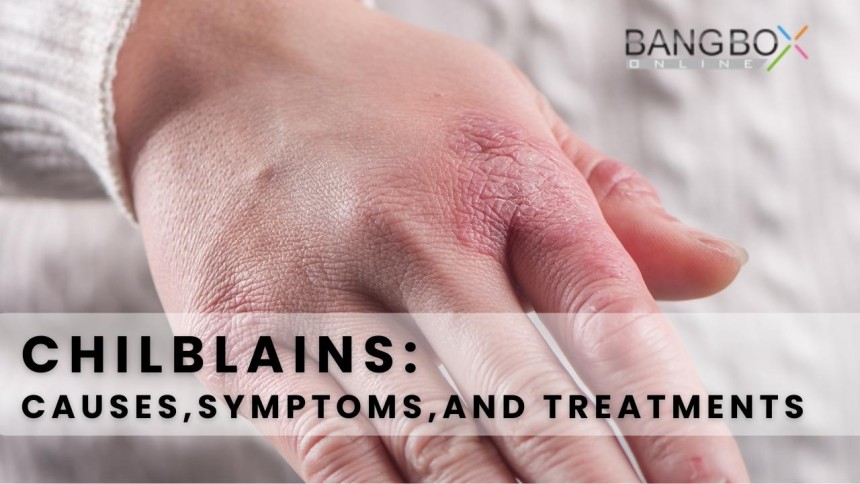
Chilblains: Causes, Symptoms, and Treatments II Bang Box Online Official
2023-07-07 06:53:45 - Bang Box Online
Chilblains, also known as pernio, is a common condition that affects the skin, particularly in colder climates. It is characterized by small, itchy, and painful red or purple bumps on the extremities, such as the fingers, toes, ears, and nose. While chilblains can be uncomfortable, they are usually not serious and can be effectively managed with proper care and treatment. In this article, we will explore the causes, symptoms, and treatments of chilblains.
Causes:
Chilblains occur when the small blood vessels in the skin become excessively sensitive to cold temperatures, leading to inflammation and tissue damage. The exact cause of this increased sensitivity is not fully understood, but several factors may contribute to the development of chilblains. These include:
- Cold exposure: Prolonged exposure to cold and damp environments is the primary trigger for chilblains. Sudden changes in temperature, such as going from a warm room to a cold outdoor environment, can also increase the risk.
- Poor circulation: Individuals with poor circulation, including those with certain medical conditions like Raynaud's disease or peripheral artery disease, are more susceptible to chilblains. Poor circulation reduces the body's ability to keep the extremities warm, making them more vulnerable to cold-induced damage.
- Genetic predisposition: Some people may have an inherited tendency to develop chilblains, as it can run in families.
Symptoms:
The symptoms of chilblains usually appear a few hours after exposure to cold temperatures and typically resolve within one to three weeks. Common signs and symptoms include:
- Red or purple bumps: Chilblains present as small, raised bumps on the skin. They are often itchy and may be accompanied by a burning or tingling sensation.
- Swelling: The affected areas may become swollen, and the skin can appear shiny or tight.
- Pain or tenderness: Chilblains can be tender to the touch and may cause discomfort, especially when warming up after exposure to cold.
- Blistering: In severe cases, chilblains can lead to the formation of blisters, which can increase the risk of infection.
Treatment:
Most cases of chilblains can be managed at home with self-care measures. Here are some tips for treating chilblains:
- Warmth and insulation: Gradually warm up the affected areas by placing them near a warm (not hot) source, such as warm water or a heating pad. Avoid direct heat as it can cause burns. Keep the affected areas warm and dry to prevent further irritation.
- Avoid scratching: Although chilblains can be itchy, scratching should be avoided as it can lead to skin damage and increase the risk of infection.
- Over-the-counter creams: Applying over-the-counter creams or ointments containing corticosteroids can help relieve itching and reduce inflammation. However, these should be used sparingly and only as directed by a healthcare professional.
- Medications: In some cases, a healthcare professional may prescribe medications, such as calcium channel blockers or vasodilators, to improve circulation and reduce symptoms.
- Protecting against further exposure: To prevent chilblains from recurring, it is essential to protect the skin from cold temperatures. Wear warm and layered clothing, including gloves, hats, and socks. Use proper footwear and avoid tight-fitting shoes that may restrict circulation.
- Seeking medical attention: If the symptoms worsen, persist for an extended period, or become infected, it is important to seek medical advice. A healthcare professional can provide appropriate treatment and guidance based on the severity of the condition.
Prevention:
While chilblains can be challenging to prevent entirely, certain measures can help reduce the risk of developing this condition:
- Dress appropriately: Layer clothing and wear warm socks, gloves, and hats to protect the extremities from cold temperatures.
- Gradual warming: Avoid sudden temperature changes and gradually warm up when transitioning from cold to warm environments.
- Keep the feet dry: Moisture can exacerbate the symptoms of chilblains, so it is important to keep the feet and hands dry.
- Quit smoking: Smoking can worsen circulation problems, increasing the risk of chilblains. Quitting smoking can improve overall circulation and reduce the likelihood of developing this condition.
Chilblains, while uncomfortable, are usually a temporary condition that resolves on its own. By taking appropriate precautions, managing symptoms, and seeking medical attention when necessary, individuals can effectively cope with chilblains and minimize their impact on daily life.
Follow us on:
Platform: https://www.bangboxonline.com/
Facebook: https://www.facebook.com/bangboxonline/
